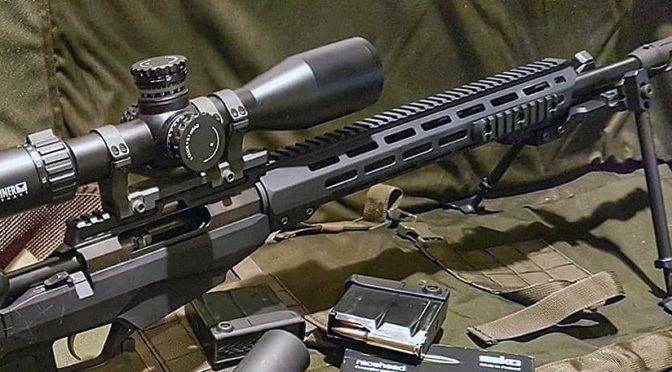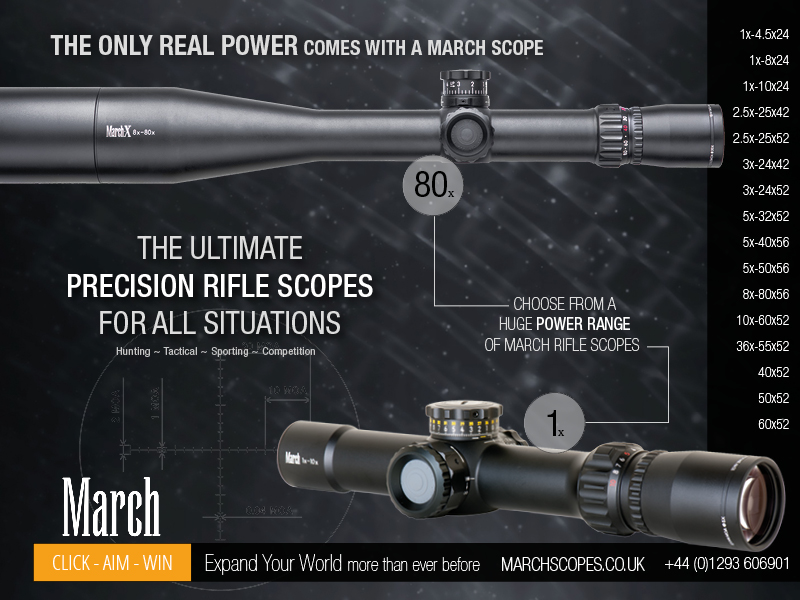We’ve looked at five out of my six nominated 6.5s, just leaving the youngest of the bunch, the nine year old 6.5mm Hornady Creedmoor. The Creedmoor proved an immediate commercial success – unfortunately just as, across the board, ammunition and components shortages struck – so cartridges and brass were often in short supply, until recently.

6.5mm Creedmoor (extreme right) is our newest mainstream 6.5, seen alongside its 6.5X47 Lapua (left) and 260 Rem (centre) competitors
Short-Case 260?
With a 1.920” (48.8mm) case-length, it lies between the Lapua (1.85” / 47mm) and Remy (2.035” / 51.7mm), but rather closer to the Finnish design. Whilst only a little over a tenth of an inch shorter than the 260 Rem case, that modest amount is valuable in allowing bullets to be seated further out and use less internal space within magazine/action enforced cartridge overall length constraints. The SAAMI maximum COAL is also marginally longer than the other two at 2.82 inches although the standard chamber sees optimal bullet seating of the 140gn AMAX at exactly 2.800” which keeps the ogive just off the lands. As with the 6.5x47mm Lapua, a less tapered (fatter) case partially compensates for being shorter than the 260 Rem in capacity terms. Also, as with Finnish design, the Creedmoor uses a 30-deg shoulder angle – instead of the old Remmy’s 20-deg – which increases the internal room slightly and should improve charge combustion consistency. We’ve seen neck length is an issue in the smaller 6.5mm designs and at 0.259”, the Creedmoor’s is identical to that of the 260 Rem but a bit shorter than the Lapua’s full three-tenths. Personally, I’d have preferred another 20 or 30 thou’ to allow a bullet to be seated at a full calibre depth while keeping its ‘pressure ring’ marginally above the ‘case-neck to shoulder’ junction and any possible ‘doughnut’.
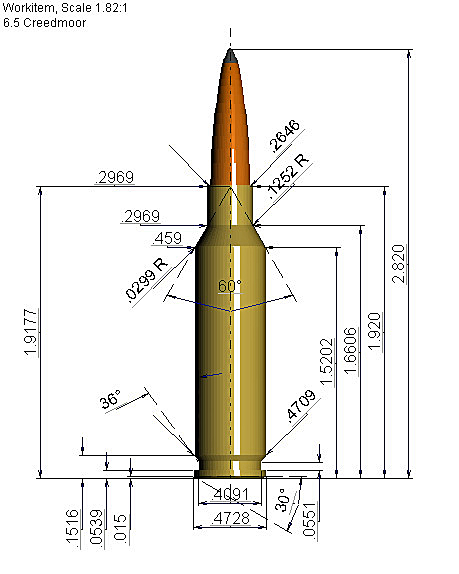
The 6.5mm Hornady Creedmoor
Figure 1 shows the cartridge’s dimensions. It shares the 308 Win/30-06/Mauser case-head and rim arrangements, as do our other two mid size 6.5s. As originally conceived by Hornady, it mirrors the 260’s primer and flash-hole set-up, that is large rifle primer with a nominally 2mm (0.079”) flash-hole, whilst the 6.5x47mm Lapua is in that elite brotherhood of precision designs that use the mall rifle primer and 1.5mm (0.059”) flash-hole arrangement. However, as noted in Part 4 on the 6.5x47mm Lapua, the Finnish company is about to supply its take on the 6.5mm Creedmoor and it will be a small rifle primer/1.5mm flash-hole job.
Case Capacities and MVs
In terms of water capacity, the trio run at:
6.5x47mm ………..48.8gn (Lapua)
6.5mm Creedmoor ………..52.5gn (Norma)
…………53.4gn (heavy Hornady)
…………53.7gn (light Hornady)
260 Rem ……………….55.1gn (Lapua)
……………….54.4-56.6gn (US makes)
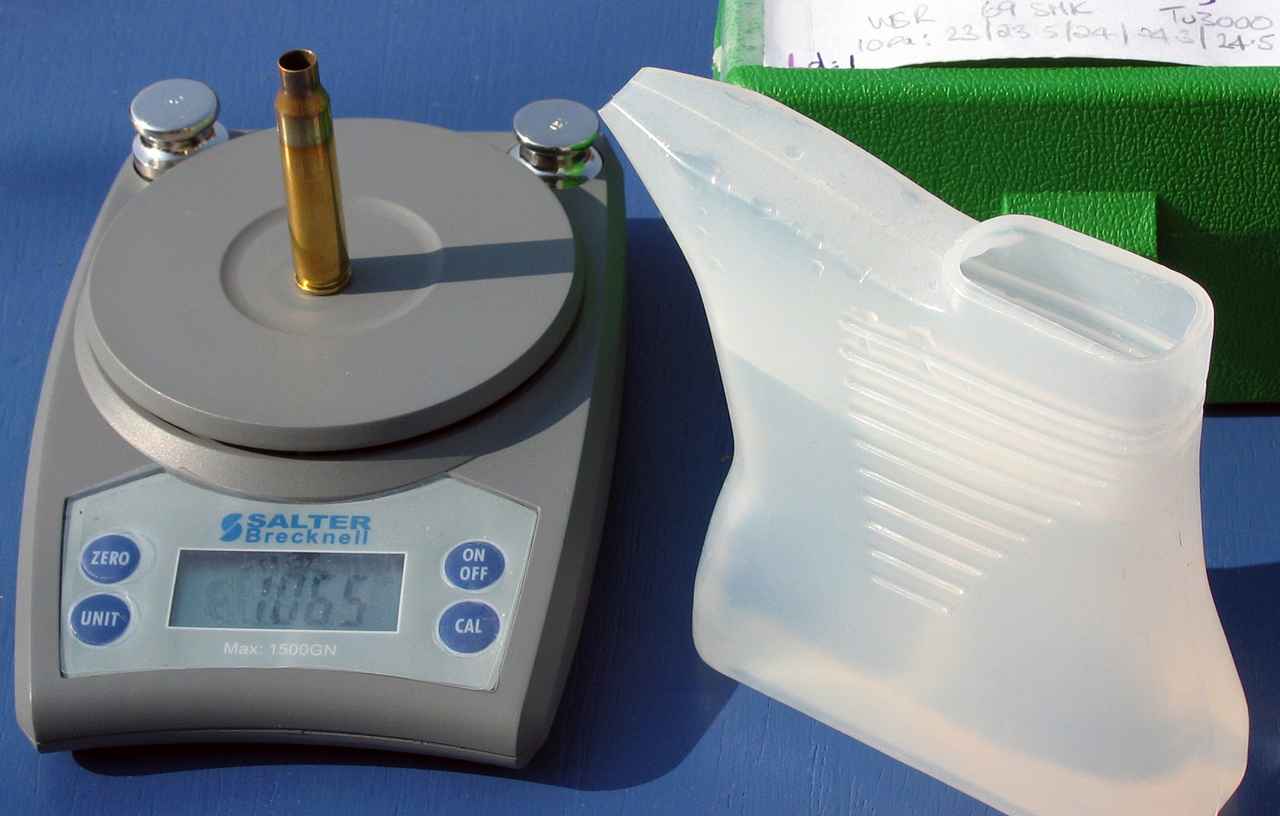
Measuring a fireformed 223 Rem case’s water capacity
These figures are from fireformed brass in my rifle chambers. So the 260 has, as noted in Part 3, a useful capacity advantage over the other two – 5% over the Creedmoor and 13% over the Lapua. However, some of that margin is lost due to the case-length v COAL relationship mentioned earlier. If we load the 123gn Scenar at the trio’s SAAMI/CIP COALs, the usable water-capacities (that underneath the bullet) become:
6.5x47mm ………44.5gn (Lapua)
6.5mm Creedmoor ………47.5gn (Norma)
………48.7gn (light Hornady)
260 Rem ………48.4gn (Lapua)
So, with SAAMI/CIP COALs and these particular makes of brass, the 260 and 6.5mm Creedmoor have near identical loaded round usable capacities. On paper specs, the Creedmoor has another 2000 psi of chamber pressure in hand over its older rival with its 62,000 psi SAAMI MAP but, in practice, I reckon there is a lot to be said for running both at or below factory ammunition pressure levels – around 57,000 psi – if you want any sort of brass life.

Expensive but high grade Norma Creedmoor brass
I would expect the new Lapua Creedmoor cases to have a similar build and capacity to the existing heavily constructed Norma version – if so, that’s a little less than the 260 but an extra 3gn of usable water capacity over the 6.5x47mm – some 7% – which in practice is often greater, as 6.5x47mm rifle chambers aren’t usually throated out enough to allow the full CIP COAL to be used.
Once we get the new small primer Lapua brass, that 62,000 psi top figure becomes accessible, potentially allowing another 1.1gn of H4350 to be used under the Berger 140gn Hybrid and seeing QuickLOAD’s estimated MV rise from 2760 fps at 57,000 psi to 2826 fps at 62,000 psi (26-inch barrel).
Note the considerable PMax and MV increases from 1.1gn of powder – this trio have fairly small cases when allied to 6.5mm calibre, something that handloaders must bear in mind as the charge approaches listed maximum values, increasing it in small steps is vital.
Sticking to the 140gn Hybrid (with an over-SAAMI 2.88” COAL for AI type magazines) and H4350, standard large primer Lapua cases will provide an estimated 2780 fps in the rival 260 Remington at a brass saving 57,000 psi PMax. The Creedmoor in small primer form should therefore provide a useful performance gain of 60 or so fps over this cartridge, also outperform the 6.5×47 Lapua by 50-60 fps.
Actually, there is nothing really new about small primer Lapua Creedmoor cases as many keen American Creedmoor users (and a few 260 shooters too) have been reforming Lapua 308 Win small primer ‘Palma’ brass ever since the Creedmoor’s introduction and they report impressive velocities. In putting the Creedmoor into production, Lapua just makes it much more convenient for everybody, not to mention making it an option for those unable or unwilling to do the neck-turning and annealing tasks that the reformed version needs before shooting.

Lapua 308 Win Palma cases were being reformed by some shooters, but Lapua’s new small primer 6.5mm Creedmoor brass makes this work unnecessary
Suppliers
Initially, there was just Hornady or Hornady for ammunition and brass, more on that below but other ammunition makers soon added it to their ranges. Federal Cartridge has two 140gn bullet loadings: an OTM ‘American Eagle’ match loading, a ‘Fusion’ expanding bullet deer load and has just announced a new match/tactical version with the 130gn Berger AR-Hybrid Tactical OTM. Nosler has its 140gn Custom Competition HPBT alongside 129gn Accubond LR and 140gn Ballistic Tip ‘Trophy Grade’ hunting versions. Winchester lists a single match HPBT version with a 0.580 G1 BC match bullet at 2710 fps MV – barrel-length not quoted but that looks about right for 24-inches.
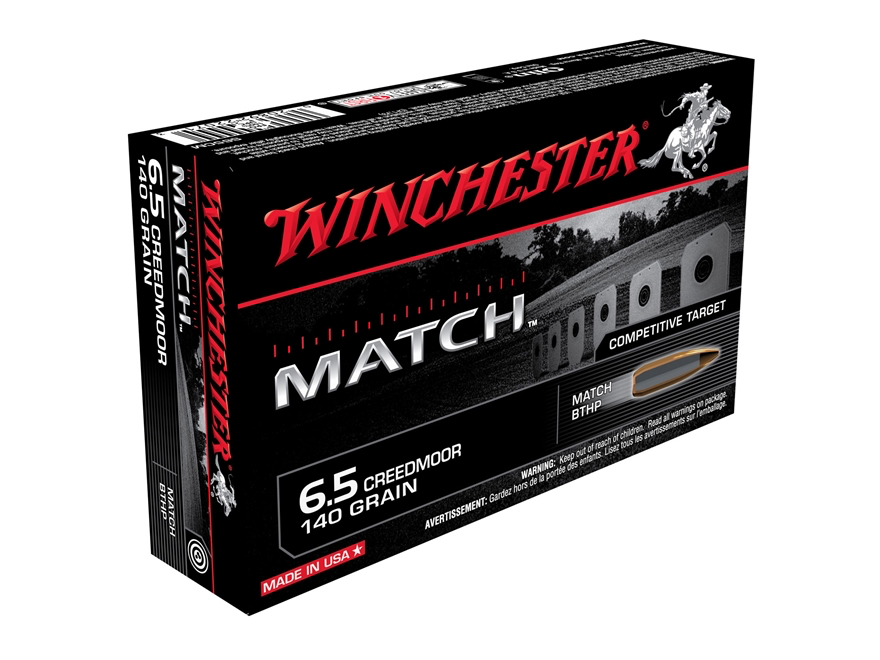
Winchester is one of several US companies which have adopted the cartridge
Most of the smaller American specialist companies we saw loading 260 Rem and 6.5-284 haven’t adopted the cartridge, (presumably because of the range of ready-made factory match and tactical examples and relatively low US prices) but, I did find three on the go – Prime Ammunition, whose products are loaded in Europe and The Copper Creek Cartridge Company which lists no fewer than 12 Creedmoor variants. There is another new American outfit called Alpha Munitions loading the cartridge and producing its own brass but I couldn’t find out much about it and an email request for information proved fruitless.
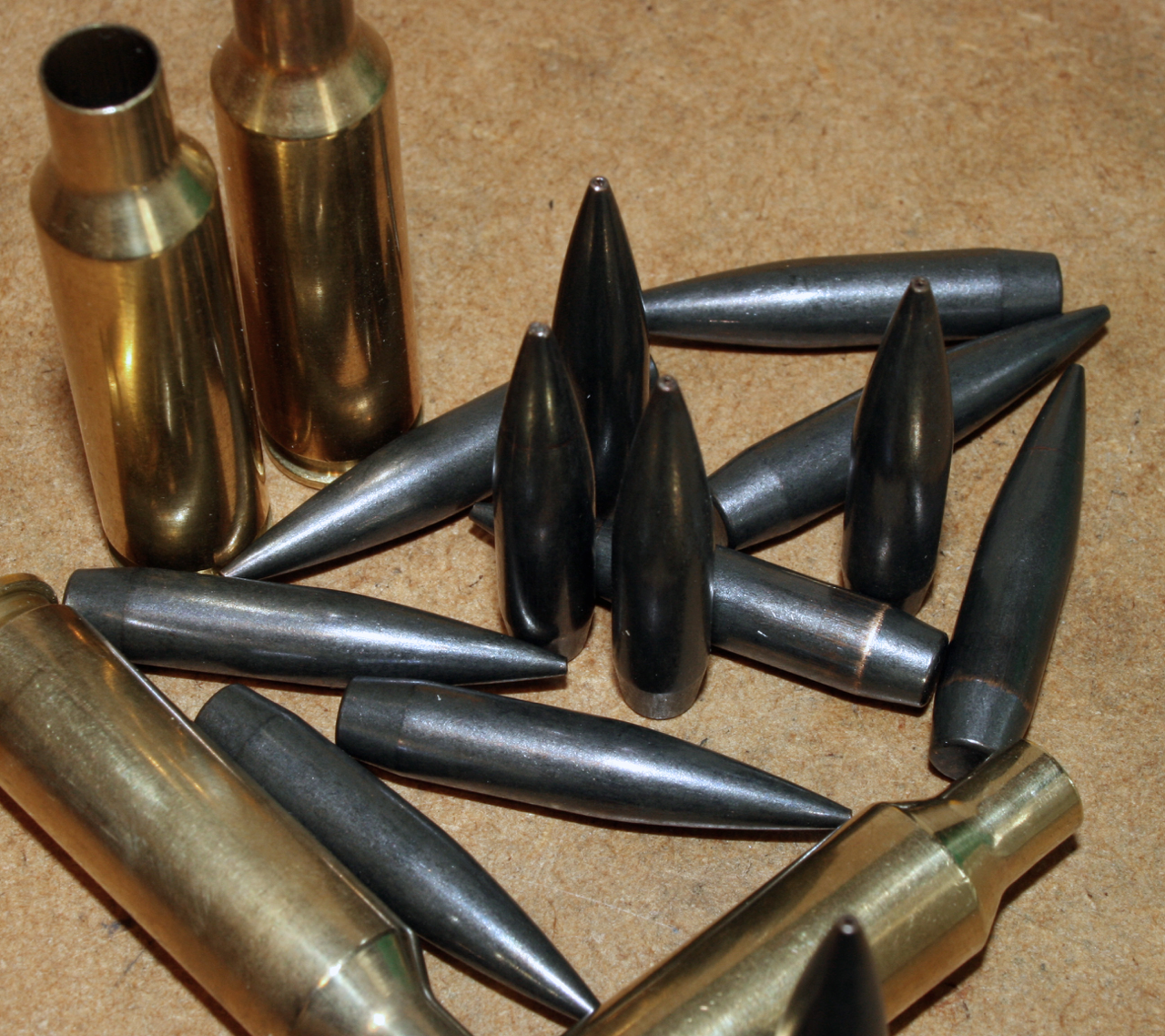
Prime Ammunition is loaded under contract by RUAG using Norma brass and the very efficient 130gn ‘Golden Diamond’ bullet seen here in ‘Black Diamond’ moly-coated form
Prime Ammunition is an American company which has been around for some years supplying American law enforcement and military agencies but has now entered the US retail market with 260 Rem, 6.5 Creedmoor, 308 Win and one or two other rifle numbers. Manufacture of these high-spec match cartridges is contracted out to the Swiss/German RUAG combine (owners of Norma Precision and RWS amongst others). Prime/RUAG’s 6.5 Creedmoor offering uses Norma brass and the very high BC (0.294 G7) 130gn Norma OTM bullet (Open Tip Match, but HPBT VLD Match to you and me) at a claimed 2,851 fps MV from a 24-inch barrel.
(We can also add Prime Ammunition to the list of US 260 Rem match products (in pt. 3 of this series), its version producing a claimed 2900 fps MV from the same 130gn Norma bullet loading, also from 24-inch barrels).
By our standards, American 6.5CM prices are modest, especially if you shop around and buy large quantities from specialist online bulk suppliers, match versions retailing at $110-125/100 from such sellers. The only brass initially available in unprimed form was Hornady’s but we now have Alpha, Nosler, Norma, Peterson Cartridge Co., Kinetic Industries and shortly, Lapua.
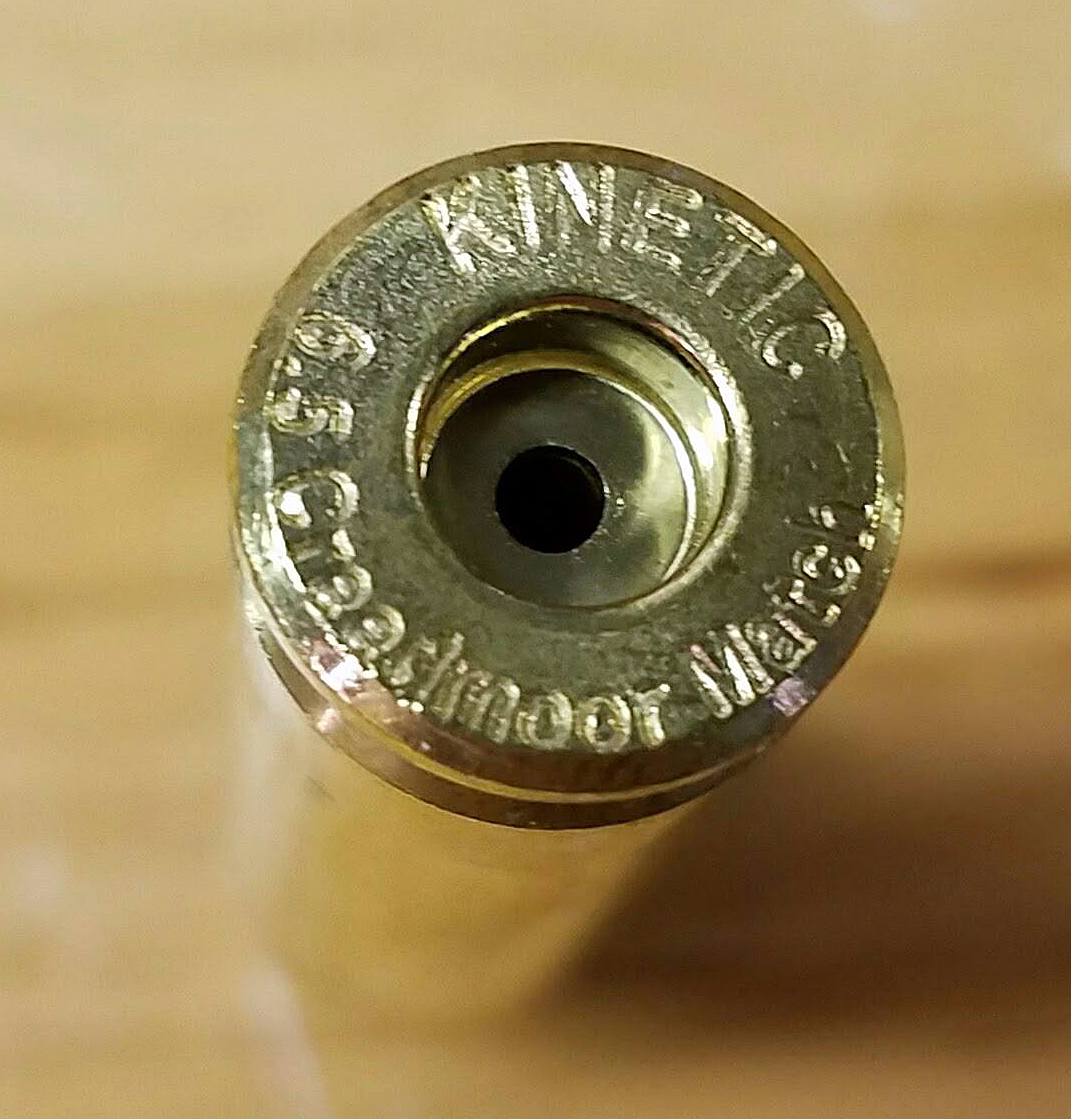
Kinetic Industries is a new name in cartridge component manufacturing, but claims to be producing match quality Creedmoor brass
Beginnings
Let’s go back some 11 years to when the cartridge was conceived ….. but first some semantics. This is the Creedmoor – ‘moor’ as in mountain, heath and moor – not ‘more’ or ‘moore’. It’s from an American place-name see, in Long Island just to the north east of New York. At the time it was purchased to build a railway branch line in the mid 19th Century, it was known as Creed’s Moor after the family who farmed it. New York State in conjunction with the newly formed US National Rifle Association then bought it from the railroad in 1873 to build a rifle range for joint militia and civilian shooting, the name by then abbreviated to Creedmoor.
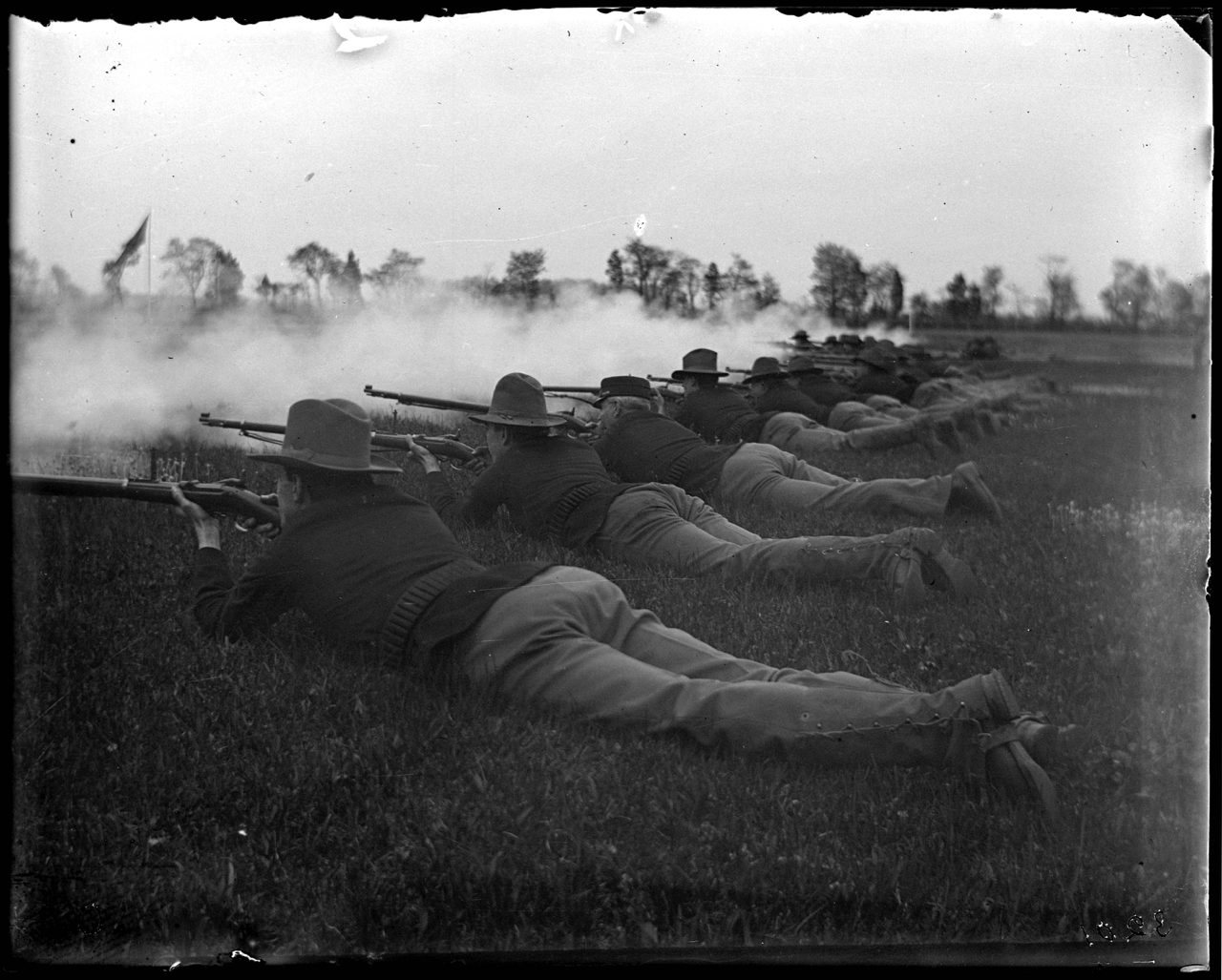
Pic 08 Members of a New York infantry regiment shoot ‘Trapdoor Springfields’ on Creedmoor rifle range in 1901
The cartridge was conceived over an after-dinner Camp Perry National Matches ‘chewing the fat session’ between Hornady’s head of engineering David Emary and Creedmoor Sports’ Dennis DeMille. Mr DeMille is the specialist shooting supplier’s general manager, a former member of the USMC shooting team, also a former US National High Power champion. Whilst the company name is one link to the adoption of the ‘Creedmoor’ handle, the other is the series of long-range international team matches held annually from 1874 to 1891 on the aforementioned Long Island range. Even now, over 100 years after the last such match and with the Creedmoor Range closed before the Great War, the name still has a strong resonance for many American long-range target shooters.
Anyway, the pair knocked around ideas and produced a shopping list for the ideal XTC match cartridge, also suitable for a range of other target disciplines and distances.
Must be/have:
• Widely available and affordable as a factory match-grade cartridge for non handloaders.
• Match-grade precision. (Defined as half-MOA on contemporary standards?)
• Ballistic capabilities to be effective at 1000 yards whilst running moderate pressures.
• Light recoil.
• COAL to suit detachable magazines in general use, ie ~2.8-inches, reliable feeding.
• High BC match bullets already available.
• Good barrel and brass life.
The 6.5mm calibre was agreed to best fit that bill, so why not adopt the existing 260 or 6.5x47mm Lapua options? I imagine the former was viewed as a dated design and better results could be achieved in an improved variant; the latter is on the small side capacity-wise and likely fell foul of the stated need for long-range performance at moderate pressures. I also imagine that the Lapua model isn’t an attractive manufacturing prospect to American case makers and, the alternative option of relying on a single foreign source, certainly wouldn’t appeal.
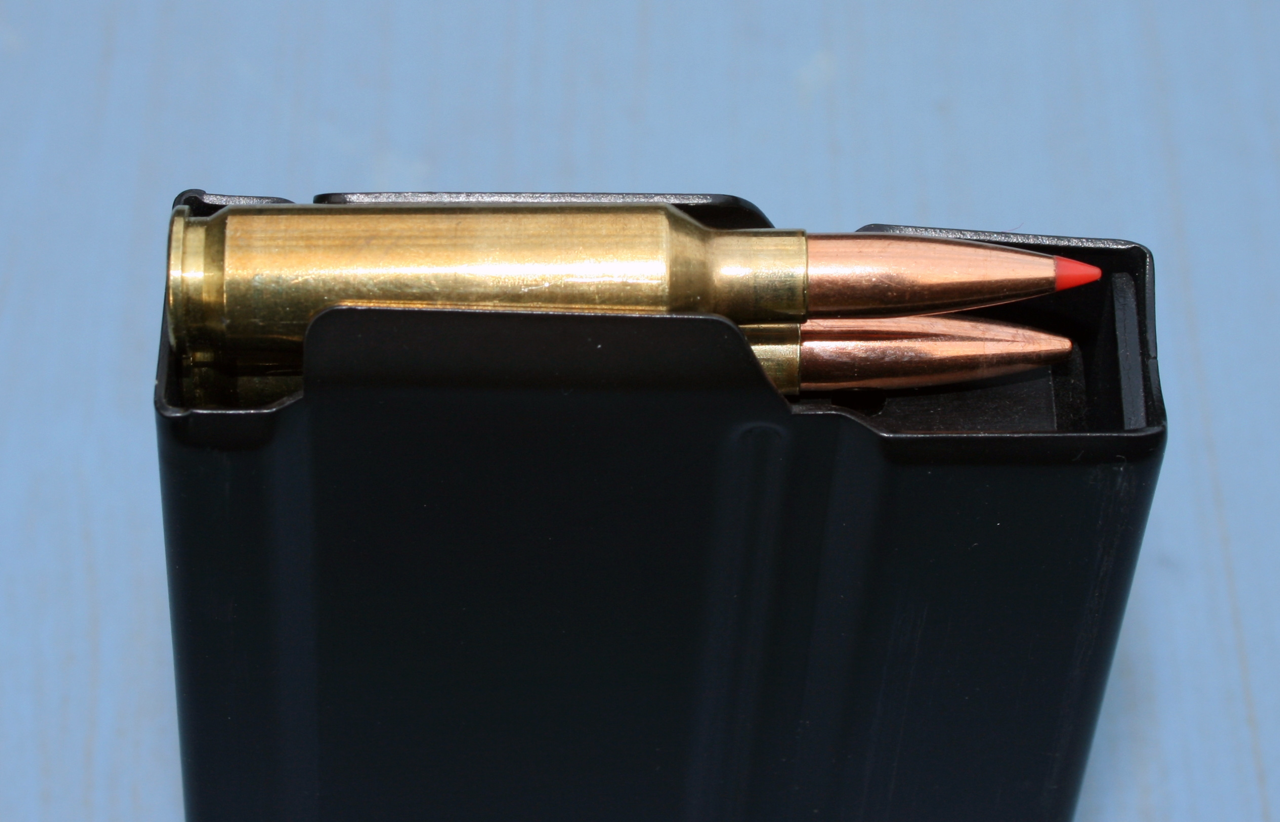
Creedmoor cartridges loaded for the industry standard chamber easily fit into AI magazines
Performance
Having said that an integral element of the DeMille/Emary concept was that unlike many cartridges in regular match use, factory ammunition would be widely available and specified as good enough for most disciplines it might be used in. Has that aspiration been met by Hornady Manufacturing’s treatment of the cartridge? Apparently so, the factory loading some very effective products, initially in two match loadings with 120 and 140gn AMAX bullets back in 2008.
American deerhunters soon asked for their versions, so a couple more were quickly added for them. Today, a mere nine years on, Hornady lists no fewer than 11 loadings, five match products ranging from the original 120gn AMAX to a 147gn ELD-M loading and, six sporting loads covering 120 to 143gn bullets and incorporating a couple of high-velocity ‘Superformance’ loadings. Match ammo routinely produces half to one-MOA groups in factory rifles and in some such off the shelf shooting sticks will drop below the half-minute five shot group level.
It seems the cartridge is better suited to 136-142gn bullets than the Lapua design and reviews often reported smaller groups from the now discontinued 140gn AMAX version than its 120gn sibling. Hornady originally claimed 2820 fps MV for this (140gn) product but, note that this was from a 28-inch test barrel, so 26-inch tube Savage LRPs could be expected to produce maybe 40 fps less and 24-inch Ruger RPRs would be 60 or 70 fps down on the factory claim. Current figures are for a 24-inch barrel and also reflect the manufacturer’s rowing back from early potentially over-pressure loadings with the two match 140s in the catalogue listed at 2690 and 2710 fps MVs, the new 147gn ELD-M loading 2695 fps.
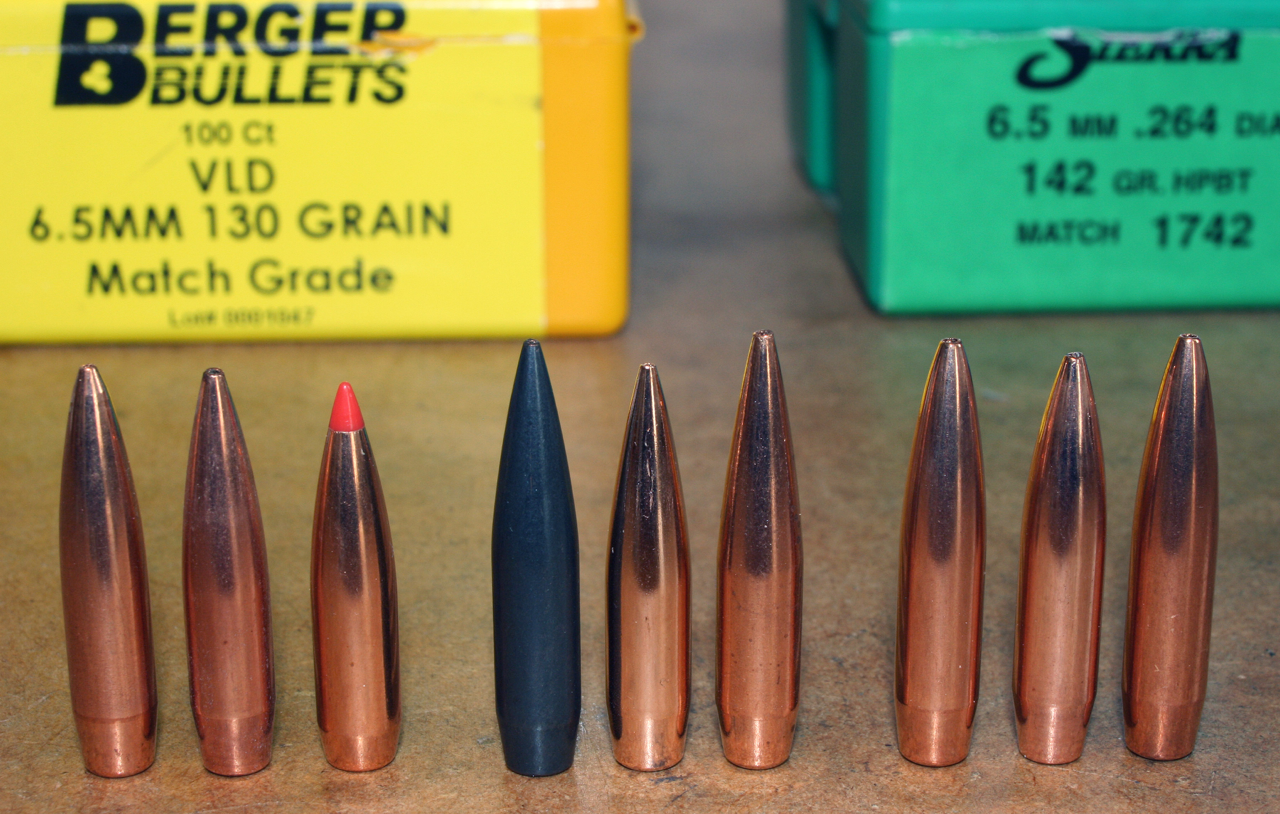
Some 123, 130, and 139-142gn 6.5mm match bullets.
Recipes
Despite its remit as a match-ready factory round, Hornady has always assumed many users will handload the Creedmoor. Most unusually, recipes were printed on ammunition cartons. Initially both 120 and 140gn AMAX loads were powered by Hodgdon H4350 but after reports of excessive pressures with the 120gn version in some rifles, the propellant was changed to VarGet with a drop in the nominal MV. Here are the original factory guidelines:
Bullet Powder C.O.A.L. MV (28” Brrl)
120gn Amax (early) 44.5gn H4350 2.720” 3020 fps
120gn Amax (revised) 40.3gn VarGet 2.720” 2945 fps
140gn Amax 41.9gn* H4350 2.800” 2820 fps
(* as originally reported but later revised to 41.5gn)
Hornady brass was unsurprisingly used throughout and the Federal 210M match primer is specified. If copying factory loads or using other makes of bullet and brass, start at lower charge weights and work up. Note the pressure issues with the early 120gn loading in some barrels. It appears that 41.9gn H4350 was on the high side for the 140gn version and the company reduced its recommendation to 41.5gn.
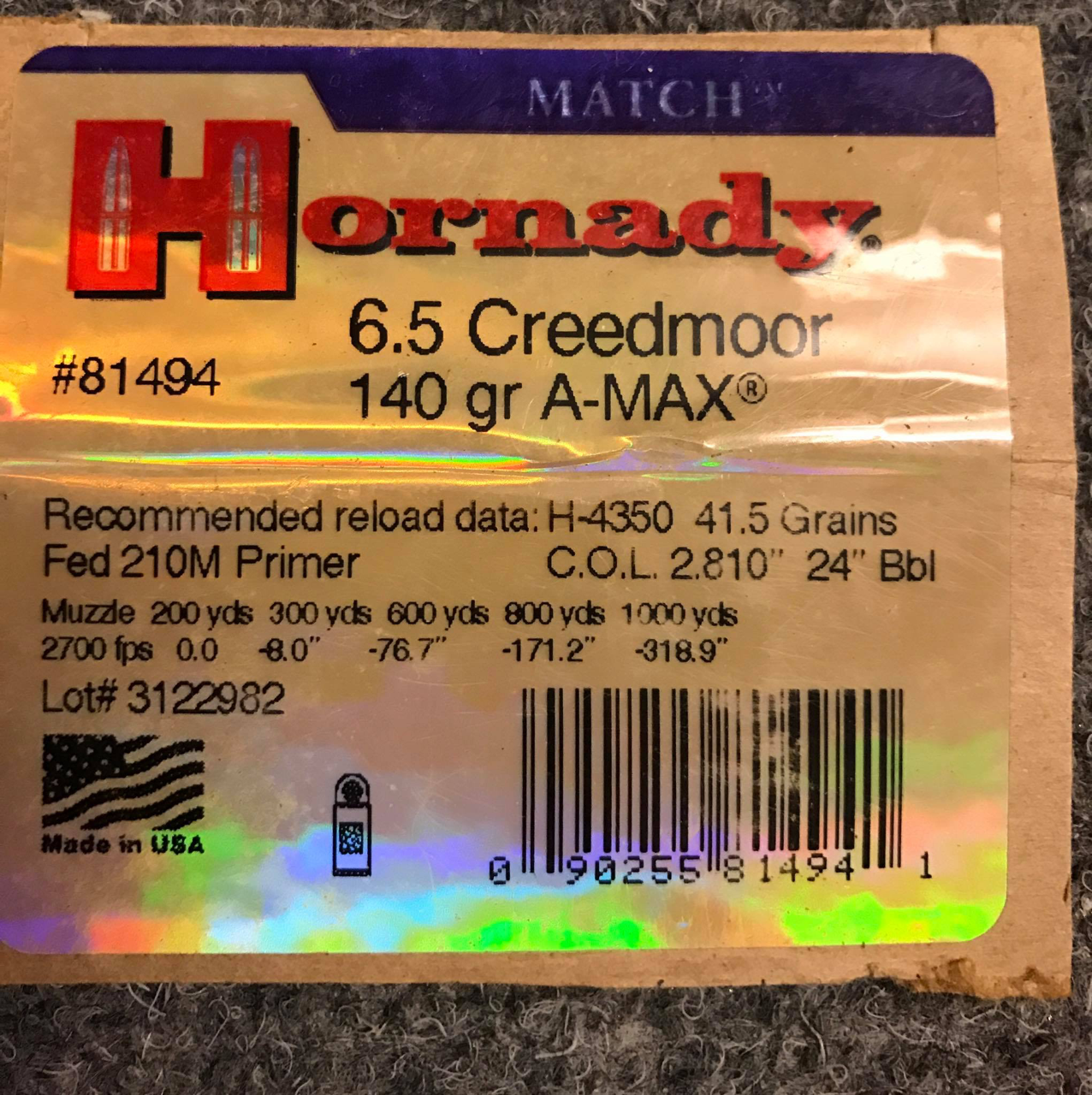
Hornady initially printed handloading recipes on its ammunition cartons
Factory ammo was a rarity here last year when I had a Savage LRP rifle on loan from Edgar Brothers, our Savage and Hornady distributors but, supplies have now arrived in quantity. In any event it was easy to duplicate the early factory recommended 140gn AMAX load in all bar primer (substituting the CCI-BR2 match type for its Federal equivalent due to component availability issues) starting at 41gn and working charges up in 0.4 and 0.3gn steps.
The top (original factory equivalent) load of 41.9gn produced just under 2800 fps, creditable considering the LRP’s 26-inch barrel but, the largest 100yd 4-shot group of the set; the initial 41.0gn and subsequent 41.4gn loads were the stars at 0.35 and 0.4-inches. The 41gn load chronographed at 2766 fps and with a Litz measured G7 BC of 0.299, that MV will see it still doing 1435 fps at 1000 yards – comfortably above transonic speeds and moved 7½ inches by a 1mph crosswind change. (As a comparison, the archetypal 308 Win reference load from a 30-inch match barrel, a high-BC 155gn bullet at 3000 fps returns 1336 fps retained speed and nearly 9-inches of windage per 1mph wind change at this distance).
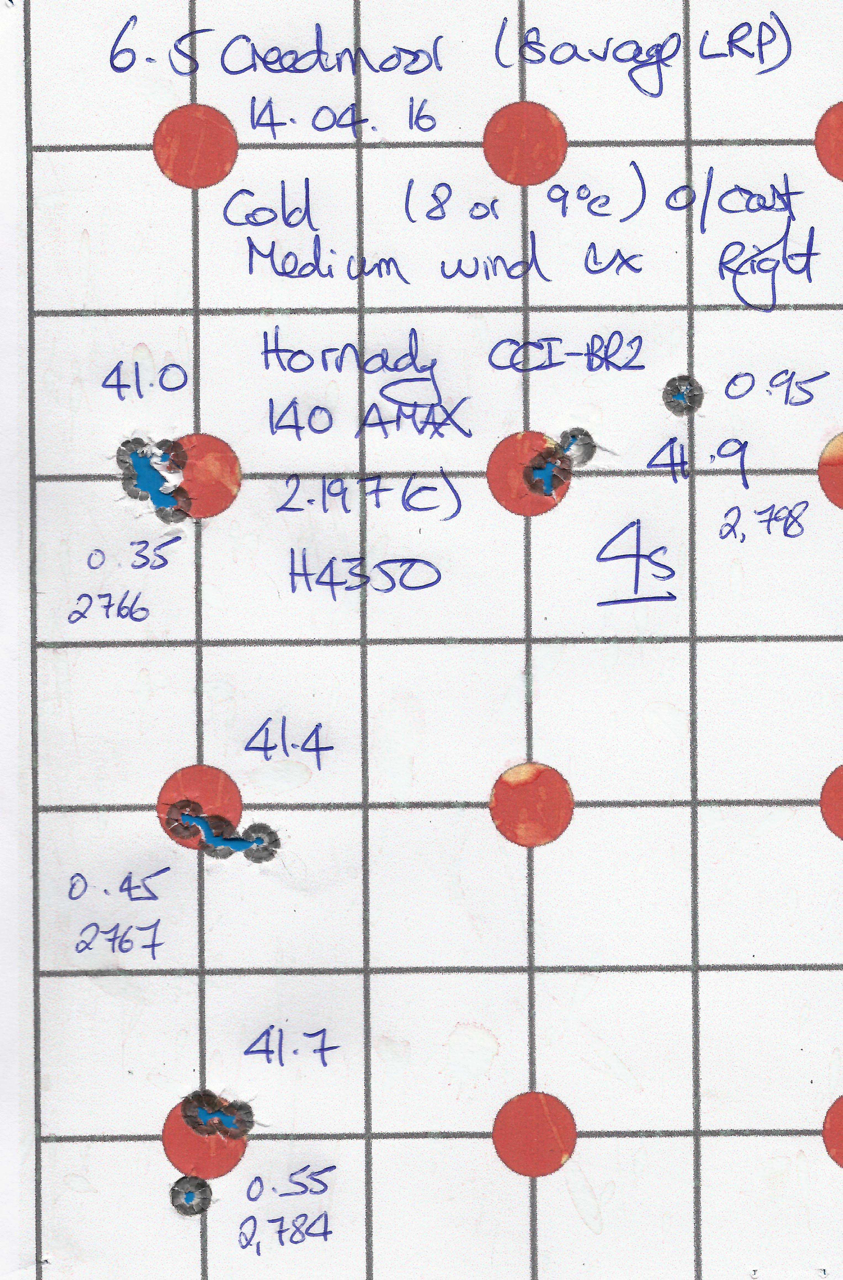
Groups produced from the factory Savage LRP using Hornady’s recommended components and load.
The 140gn AMAX (now ELD-M) and H4350 combination is a natural for this cartridge, not too surprising with the rifle chamber designed around it but I actually got slightly better results in the ‘out of the box’ Savage with the lower BC Nosler Custom Competition HPBT of the same weight over Reload Swiss RS62 powder in superbly consistent Norma cases at a modest MV just above 2700 fps. This gave me a best (out of four) five-round group of a shade over 7 inches in a 1000 yard BR comp at Diggle and an ‘agg’ good enough to take 5th overall against a bevy of custom BR rifles.
Soft Heads
Early Hornady production attracted considerable criticism for ‘soft’ case-heads, at least part of which was over-ambitious handloading and resulting high pressures, also for production variability. I have 300 early examples which apparently came from two production lots, giving a vast difference in weights and a 0.3gn difference in water capacity after weight measurement and batching. Neck thickness consistency is very good but, uniforming flash-holes proved essential with some great chunks of brass left partly blocking their outlets. (See photograph for the worst examples). Recent cases are said to be good, shooters are happy with their performance and getting six to 12 loadings out of them depending on the pressures being produced – but, make no mistake, they won’t take the cartridge’s 62,000 psi rated maximum, or not for more than a couple of firings anyway. Hornady itself has had to downsize its original factory ammunition loadings after complaints about leaking primers and expanded primer-pockets on maiden use, problems which the company blamed on non-SAAMI spec 6.5 barrels.

Metal removed in uniforming flash-holes in early Hornady cases. Note the huge figure 5 and 8 pieces next to the Lyman tool point.
One thing which puzzled and impressed me was the short timescale involved in the cartridge’s development and introduction. There was barely a year between Messrs Emary and DemIlle’s dinnertime discussion and ammunition and rifles being in American gunshops. Various parties must have really pulled every stop out to achieve this but one help was that Hornady didn’t have to start with a clean sheet of paper. The company had developed a high-performance 308 Win lookalike called the 30TC for Thomson-Center Arms a few years before. Although a commercial flop, this short-case 308 with 30-degree shoulders provided a starting point for the Creedmoor. In effect, Hornady necked the TC case down and made some small changes to the shoulders mirroring Remington’s creation of the 260 out of the 308 Win a generation before.
Rifles
As with other recent Hornady introductions, the company collaborated with Sturm Ruger and Savage Arms during the development period, so that rifles in the chambering were launched simultaneously. Howa joined in as of summer 2015, adopting it as a ‘mainstream’ chambering option. American semi-custom builders including DPMS, G.A. Precision and McMillan came onboard at the time of the launch and Hornady worked with Dave Kiff of Pacific Tool & Gauge to have an industry standard chamber reamer available from day one so that factory ammo would perform well in gunsmith built rifles.

Savage 12 LRP (Long Range Precision) rifle in 6.5mm Creedmoor.
Although European rifle manufacturers largely ignored the 260 Rem for a quarter century and have barely dabbled with the 6.5×47 Lapua, Sauer offers the Creedmoor in its 100 series stalking rifles and Blaser has a quick-change sporting profile barrel for the R8. Tikka has adopted it for its ‘tactical’ models but we’ll have to see if 6.5 Creedmoor sporters are to be listed right across the Tikka and Sako ranges. Ruger’s bestselling ‘Precision Rifle’ gave an already moving bandwagon a huge shove in the USA and introduced many shooters here to the new cartridge, even if the rifle garnered more UK sales in 308 initially. The RPR started its own bandwagon rolling too of course, affordable factory ‘blacktical’ rifles.
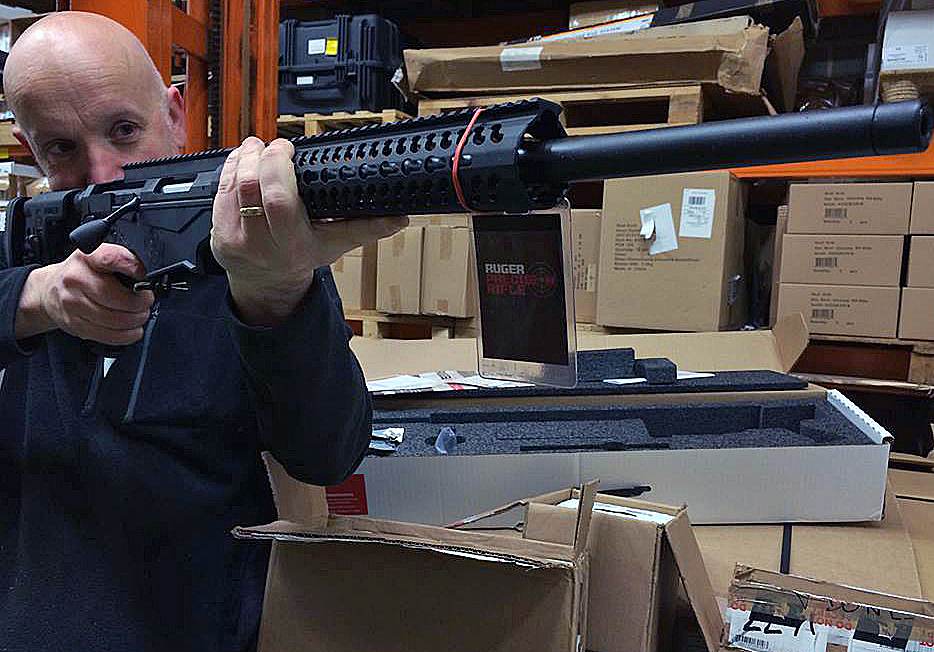
A new Ruger Precision Rifle is unpacked in Viking Arms’ warehouse
Blacktical
During the last year or two, Bergara, Howa, Savage, Tikka, Weatherby and Winchester have announced new ‘Blacktical’ models which, like the Ruger PR, are listed below the US PRS (Precision Rifle Series) Production Class maximum $2,000 MRSP figure. All are offered with 6.5 Creedmoor as a calibre option and its combination with the rifle-type has produced an energetic bandwagon. We Brits also have the Italian Sabatti STR and Victrix Armaments rifles (mentioned in conjunction with the 6.5×47 Lapua in part 4) as more factory Creedmoor offerings.
European tactical rifle Tikka fans have been pressing hard for the T3x-CTR (Compact Tactical Rifle) to be made available in the calibre. This finally seems to have happened (for US buyers anyway) and the higher specification T3x TAC-A1 chassis stock model appeared at SHOT 2017 in 6.5 Creedmoor. In any event, any manufacturer with aspirations to produce a Ruger PR type ‘tactical’/general-purpose rifle for the American market knows that 6.5 Creedmoor chambering is a must-have option these days. Ignore that and you simply won’t be taken seriously. I ’d say the British market is getting there too.
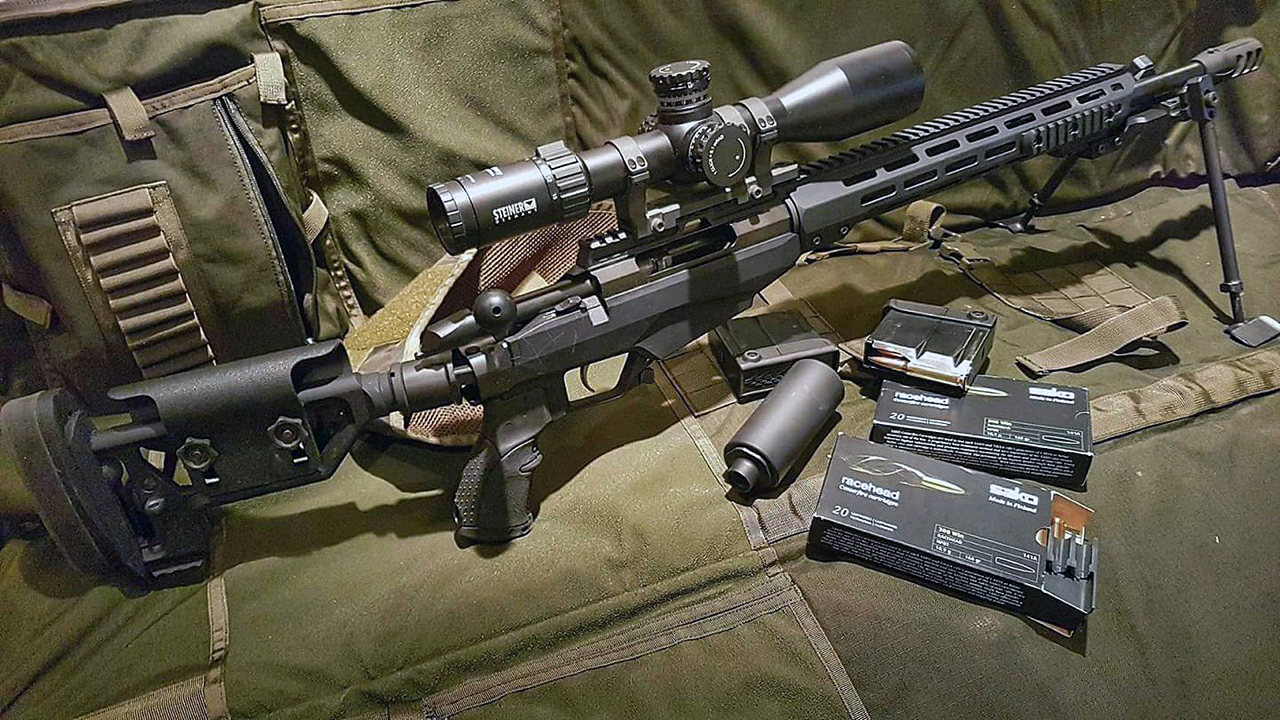
The new Tikka T3x TAC-A1 which was officially unveiled at SHOT 2017
Finally!
So, there we are at the end of this saga (finally!). A lot of words – likely far too many – but I hope sharing some reflections on these six and a half mill cartridges has been useful and reasonably entertaining.
So! (So??) Alright, you want to know which is ‘best’, don’t you? Put the little Grendel and the big, hot 6.5-284 to one side as specialist numbers and we have four cartridges giving pretty similar performance, all capable of doing the same jobs whether on the hill or on the range – 6.5×47 Lapua, 6.5mm Creedmoor, 260 Remington and 6.5×55 SE/SKAN. All are capable of superb precision and will hit bits of paper 1000 yards or further away in suitable rifles; all are very capable light and medium game numbers.
I have, and I expect I will until I pop my clogs – as they say in Yorkshire – a great deal of affection for the 6.5×55. A cartridge doesn’t hang around for 123 years as this one has and still be offered as an option in several manufacturers’ best or mainstream grade rifles unless it has a great deal to offer. Great brass, widely available in the UK and Europe as factory ammunition, it may be restricted to 55,000 psi loads (and in modern rifles at that) but, I like the idea of the bigger cartridge doing the job at lower pressures. The only drawback being COALs too long for the popular 2.8 inch mag. and a casehead diameter (0.480”) slightly larger than the ‘standard’ 308Win (0.473”).
That leaves the 260, 6.5×47 and Creedmoor. They’re all good – I for one am hard pressed to play favourites here. The poor 260 hasn’t been supported as it deserved – a handful of deer loadings from the factories, precious few rifles chambered for it. Where was Remington when US competition shooting pacesetters were using its cartridge in potent and accurate XTC, sniper, tactical, then PRS loadings mostly in custom rifles from McMillan, GAP and suchlike, all with handloads or offerings from small specialist ammunition producers? Was it so out of touch with potential customers that it was left unaware of the way that the shooting sports and market sentiment were moving… or is Big Green just plain indifferent to what happens on American rifle ranges these days?
Given Remington’s close involvement over many years with the US military in the development of futuristic modular tactical rifles, where is the mainstream market Remy ‘Blacktical’ rifle chambered for its cartridge? It has been left to others to set the pace, primarily Ruger with its Precision Rifle, and it unsurprisingly offers the more up to date Creedmoor take on the medium 6.5 concept. It’s astonishing that half a dozen ‘boutique’ or mid-size ammunition producers – Prime, ABM, HSM, Cor-Bon etc – can produce a good size clutch of precision long-range match cartridges in 260 (and make a living selling them) but the company whose name the cartridge bears has never offered a single match version so far as I’m aware!
The little Lapua may be the most inherently accurate design of the bunch. It certainly got off to a good start with its small primer case-head design and a rifle chamber developed with Grunig & Elmiger. Its lack of factory take-up is its Achilles heel – hardly a rifle to be had and only Lapua producing ammo and brass. It might be the current darling of those having custom rifles built, or gunsmith chambered and fitted match-quality barrels put on a shooting-stick that set out chambered for something else but, this is a fickle market and cartridges go out of favour as unpredictably and quickly as they come in. It has a great plus of being so well matched to short-barrel moderated multi-purpose pieces and they won’t go out of fashion anytime soon. However given the absence of major corporate support (Lapua aside), its long term survival will depend on it being adopted as a precision orientated custom rifle/handloading staple in both 6mm (‘wildcat’) and 6.5mm versions alongside the 6mm BR and its Dasher, BRX etc offshoots. That may well happen and Lapua has a reputation for sticking by its customers, so any fall in demand won’t see the company stop producing brass.
The Creedmoor is that once or twice in a generation cartridge design – the one that everybody talks about on the range, or nowadays on Internet forums; the instant hit that can’t be made fast enough by its original designer/producer to meet demand, that competitors rush to adopt; that every rifle manufacturer makes mainstream within a few years and features prominently in every new model announcement.
The design carries on the good work done by the 260 and 6.5×47 Lapua in making 6.5mm calibre cartridges a viable alternative to the ubiquitous 308 Winchester as an all-purpose target cartridge. Moreover, it appears to have achieved the major commercial breakthrough that the earlier designs didn’t get.
This is the obvious 6.5mm choice for the buyer looking for a good quality affordable multi-purpose factory rifle, especially a newly introduced ‘Blacktical’ model, and which has good factory ammo available if handloading isn’t immediately considered. It too has a 6mm spin-off, originally a wildcat but now a Hornady factory offering. (Ruger has replaced its 243 Winchester version of the ‘Precision Rifle’ with a 6mm Creedmoor model, the barrel length, profile, and rifling pitch rate optimised for the factory 108gn ELD-Match bullet loading and which should produce around 3000 fps in the RPR’s 26-inch barrel).
Some 6.5×47 Lapua fans hate this number and attempt to downplay it on forums with various criticisms or at best faint praise, sure in their own minds that it’ll never be in the same league as their darling, precision-wise that is.
Well, we’ll have to wait and see about that – maybe so but their worst fears may yet come to be realised. The new small primer Lapua Creedmoor brass does much to level the playing field allowing significantly higher pressure loadings still within the SAAMI limit and, it should help tighten MV spreads and groups too. No doubt we’ll see chamber refinements as time goes by – the Creedmoor is still a work in progress.
Personally, I believe it’s a slightly better all-rounder than the Lapua design because of its 7% or thereabouts extra usable case capacity. The little Lapua worries me as having a case that’s just a bit too small for what people want to do with these cartridges encouraging serial over-loading. (Of course, there will be those who’ll do the same thing with small primer Lapua Creedmoor brass – expect forum reports soon of 140s approaching 3,000 fps MVs!). Nevertheless, bear in mind that this trio (or quartet if you include the 6.5X55mm SE) are all capable of superb precision and I’m talking about marginal differences here. Brass availability and price; shooting sports and competition disciplines; rifle type and whether factory or custom built; bullet weights/models being loaded; need for factory ammo are all relevant and should be weighed in making your decision if trying to select one of them.
So, that’s my take on the 6.5s, a personal and undoubtedly biased one. Meanwhile … I’ve got rather keen on the sevens!
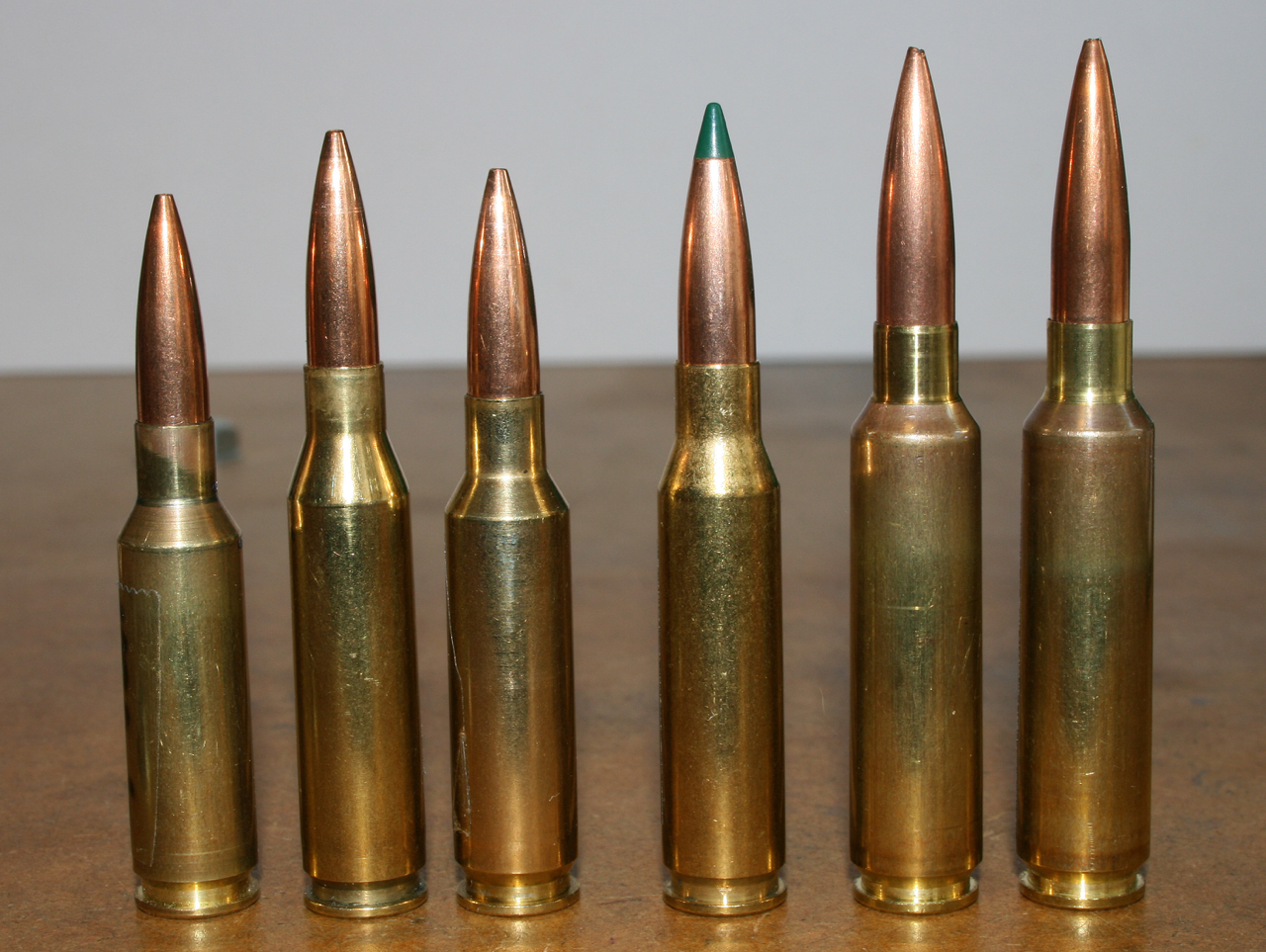
Pastures new – left to right: 6.5x47L, 260 Rem, 6.5 Creedmoor, 7mm-08 Rem, 284 Winchester and 284 Shehane, the 7mm cartridges in over-SAAMI COALs for long freebore match chambers.
(Laurie – thank you for this series of articles on the 6.5 cartridges. They have been very well received by readers around the world. May I also point out to readers that Laurie carries out all his handloading and rigorous testing completely in his own time and at his own expense – which at least means total impartiality in his findings – Ed).

